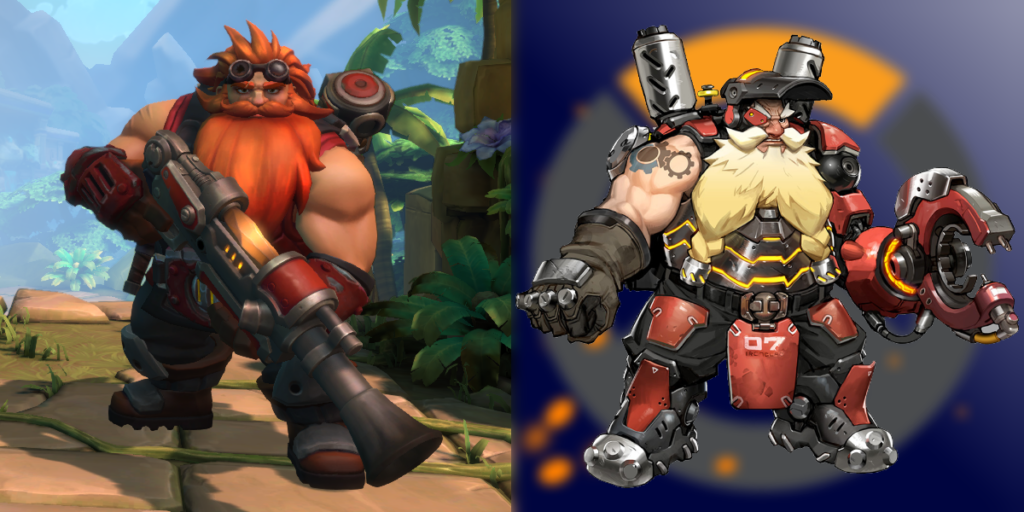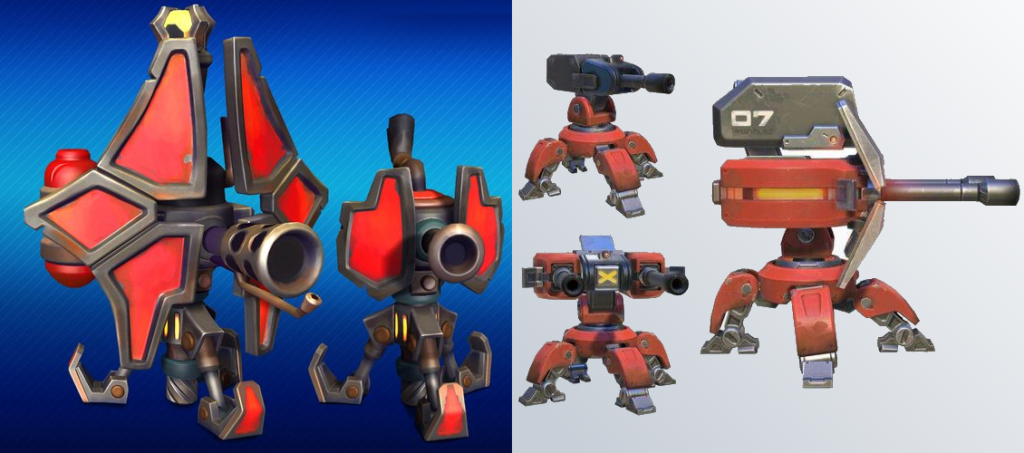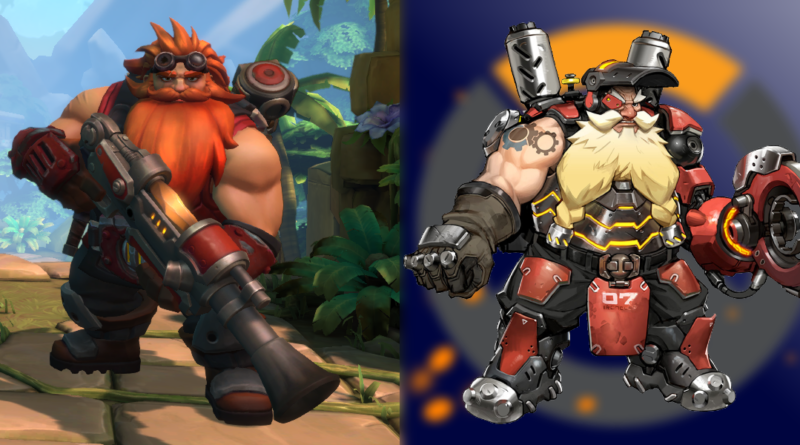Comparing Barik and Torbjörn
Considering how similar Barik and Torbjörn are at first glance, I feel that there is actually a lot of difference in how their kits are designed and implemented. I feel that a comparison between both characters’ kits can give rather valuable insight into the differences between both games, and how the games are designed and built.

Firstly, some background on both games are needed. This provides some necessary context as to how the heroes are designed.
Overwatch has 4 main game modes. In Assault, the attacking team tries to take down two control points defended by the other team. Control is a best-out-of-three king of the hill game. In Escort, attacking team escorts a payload while defenders prevent their progress. Lastly, Hybrid has one control point, followed by one payload, with one team on offense and the other on defense. In Overwatch, you have no hero customization, but you can swap heroes during the game.
Paladins have three main game modes. Siege starts off with a king of the hill control point, then the team that captured the point must escort a payload to a point near the enemy spawn. Onslaught has a large capture zone, and to win you need to earn tickets, either by being in the capture zone with no enemy players inside, or by killing enemies. Lastly, there is Team Deathmatch, where the first team to forty kills wins. You cannot swap champions during the game, but you can buy items during the game, MOBA-style, to help you against specific champions in that game.
You also get to customize your champion at the start of the game by choosing a loadout and a Talent. A loadout is built out of five cards from a selection of sixteen, with each card buffing a skill or an attribute of the champion. After choosing your five cards, you can allocate one to five points per card to increase the card’s potency, and each loadout must have 15 points allocated across all the cards, no more, no less. Talents changes a particular skill or an attribute, either by buffing it by more than what a 5-point card can do or completely changing said skill or attribute, and you choose one Talent out of a selection of four at the beginning of the match.
Aside from that, the maximum HP for the characters in Overwatch and Paladins scale differently. In Overwatch, hero health pools range from 150 to 600. In Paladins, champion health pools range from 1800 to 5100. Overwatch has health packs, while Paladins allows the champions to regenerate back to full health after being out of combat for some time. Both games give their characters unlimited ammo, but a limited clip size, so while they need to reload from time to time, they do not need to manage their reserve ammo. In both games, you cannot have multiple of a character in one team.
With the necessary context, we can begin to analyze the two stocky builders. The main similarity between Barik and Torbjörn, gameplay-wise, is that they can build turrets, which grants them a degree of area denial. However, their turrets functions rather differently from each other.

With cards, you can passively repair your turrets by being near it, get health from your turrets, increase the turrets’ health, and decrease their deploy time. Aside from that, there is one Talent, Architectonics, which reduces the cooldown between deployment by three seconds, and increase DPS of the turrets by 20% to 144 DPS. Do note, although it is possible to use all of the above cards and Talent to boost your turrets, Barik has 12 other cards and three other Talents at his disposal, which buffs his other skills and attributes. You may not want to focus solely on your turrets.
Meanwhile, Torbjörn’s turret deals hitscan damage, can can be healed by hitting it with his hammer for 50 health per swing. A level 1 turret has 150 HP and 28 DPS, and a level 2 turret has 300 HP and 56 DPS. It takes 5 hits from Torbjörn’s hammer to upgrade a full-health level 1 turret to level 2. Torbjörn can repair his turrets when they are damaged by hitting it with his hammer, and repairing takes priority over upgrading, so Torbjörn’s hits will repair any damage before upgrading his turret. There is an 8 second cooldown between deployments, and he can only have one turret active at a time.
| Turret stats | Lowest health character in-game | Highest health character in-game | ||||
| HP | DPS | HP | Time to kill (s) | HP | Time to kill (s) | |
| Torbjörn’s turret (level 2) | 300 | 56 | 150 (50% of turret) | ~2.7 | 600 (200% of turret) | ~10.7 |
| Barik’s turrets (two turrets out) | 1400 (default, combined) | 1200 (default, combined) | 1800 (~128% of turret) | ~0.7 | 5100 (~364% of turret) | ~4.25 |
As you can see, Torbjörn’s turrets, when fully upgraded, is tankier than two of Barik’s turrets, but less lethal. Torbjörn’s turrets are much better as a deterrence in a defensive scenario, while Barik’s relatively glass cannon-y turrets are better suited for more aggressive pushes.
The differences between the turrets are due to the way Overwatch and Paladins are designed. In Paladins, the champions need to be less specialized as there is no champion switching allowed. Aside from that, in Siege, champions have to be viable on both defense and offense, as they may need to play either role depending on who captured the point. Overwatch, meanwhile, features hero switching, so you can swap out heroes depending on the situation. This means that the heroes in Overwatch can afford to be more specialised.
Torbjörn’s turret requires more setup to reach its full potential, and once it is upgraded to level 2 it is generally best to keep it that way instead of knocking it down and building a new one. In general, Torbjörn’s turrets expects people to come to it. Barik’s turrets, on the other hand, are much more disposable, since they are weaker, requiring less setup to reach their full power individually, and cannot be repaired by default. Not being able to repair the turrets (by default) makes it more practical to just deploy new ones. This encourages Barik players to constantly deploy new turrets and push forward, which is vital since Barik needs to be viable on offense as well as defense, while Torbjörn does not.
However, this does leads to a problem for Barik. While he can certainly perform well in a offensive scenario, slamming down turrets ahead and pushing in aggressively, he has much less staying power, since his turrets are rather fragile and his HP, while not low, isn’t exactly high either. Thus, with just his turrets, he does not function too well under a defensive scenario.

To allow him to function better in a defense scenario, Barik gets a shield, which protects him, his turrets, and his team. Anyone who wants to damage Barik or his turrets will need to go through the shield and near Barik, and Barik’s Blunderbuss, a shotgun, is a lot more lethal at close range. Aside for that, Barik has Rocket Boots, a 1 second long dash that allows him to quickly reposition or get away from incoming danger.
Torbjörn, on the other hand, has a passive that allows him to collect scrap that all players, including his allies and himself, drop upon death. He has a maximum capacity of 200 scraps and he passively regenerates 2 scraps per second. He can drop an Armor pack at the cost of 50 scrap, which grants players who picked it up 75 armor. Armor is different from health in that armor reduces damage taken to it by 50%, up to 5 HP per hit. This lets Torbjörn have a semi-support role as he can give his allies some extra HP. Presumably, he can scavenge the battlefield for scraps once the opposing team is gone, letting him create armor packs to prep his teammates before the next wave of attackers arrive. It is, in my opinion, an extremely good defense-oriented ability.
Lastly, their ultimates. Torbjörn’s Molten Core temporarily upgrades his turrets by one level, making a level 1 turret level 2 and a level 2 turret level 3, the latter allowing the turrets to shoot rockets. It grants Torbjörn an extra 300 armor and allows him to attack, build, and repair faster. Barik’s Dome Shield, on the other hand, deploys a 20,000 HP dome shield with a Flamethrower turret inside that has 400 DPS. Both ultimates are mainly meant for area denial.
The comparison between Barik and Torbjörn reveals some fundamental design philosophies behind character kit design in both games, which is in turn caused by how the games are structured. Barik, and by extension all the other Paladins champions, are more all-rounded due to their need to excel in both offensive and defensive scenarios as Paladins does not have champion switching. Overwatch, meanwhile, has the freedom to design heroes specialized for a particular role as players may swap heroes to adapt to the game.
It is interesting to see how the same core idea – guy who builds turrets – can create two rather different characters because of the game the characters are made for. And it is also interesting that both games’ art departments immediately think “dwarf” when they are supposed to design a builder character, even for the non-fantasy game.

This was written before Torb’s rework, by the way.